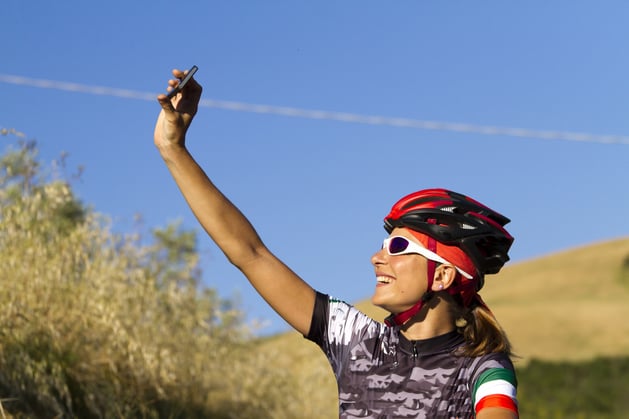Your next cycling adventure is getting closer and you are considering becoming more skilled at taking pictures with your iPhone or other smartphone. Your future self will thank you when you're looking back at those memorable days through your images.
The first thing to consider is what to bring. If you own a good reflex or mirrorless camera consider bringing it. That and a modern smartphone will allow you to take home plenty of on-the-road memories. But, let's say that you don't own a camera or that you prefer not to bring it along. You are motivated to take the best advantage of your phone capabilities that you can.
Taking a great photo on your smartphone is not as simple as pointing and shooting. There are plenty of bad smartphone photos out there. I'm sure you've seen them. By following some simple steps you can improve the quality of shoots quite a bit.

Go Take an Apple Workshop (free).
While there are millions of iPhones on the market, too few people learn how to take full advantage of their pixel power. Luckily, the good folks at the Genius Bar in Apple stores offer free workshops on how to take photos with an iPhone and on how to do some editing with iPhoto.
Go to the Apple.com learn page, and login with your Apple id. Choose the course, the location of the nearest Apple store, and when to take the class. The course is a great occasion to ask questions to uncover all the little secrets of your iPhone camera.
Update Your iOS and sign up for iCloud.
In a Time article republished by Travel and Leisure, I was reminded of how awful it is running out of memory space while attempting to take a photo. That problem has been mitigated since iOS 8.1 was launched (iOS is Apple's proprietary operating system). You are now able to store (for a reasonable fee) lots of your data - including photos - in iCloud. At the same time, your photos can be synced between all of your Apple devices. Read the article Take More Vacation Photos with This Easy iPhone Hack.
Ride using your peripheral vision.
When you ride your usual home routes it often feels like a workout and you focus on the road ahead of you, or on the wheel of the rider in front of you. While on your bike tour, you should try to change that habit. Let your eyes wander to spot stunning and unusual sights. Wildlife, tiny churches, and silly signs are all around you. I spotted the following WWII bunker in Sicily and that was a keeper.

Get clues from your guides.
Before the route review, ask the guides where the most scenic spots will be for that day. They will be able to tell you where they are and where you should position yourself to take the best shots. A few miles before those spots, rush a couple of minutes ahead so that you can take photos of your smiling fellow riders. Then, rush on to the next good spot. It's great training, too!
This amazing infographic appeared on a very comprehensive article titled How to Take Great Travel Photo on Your Phone:
The following guidelines appeared on Hubspot's excellent marketing blog here.
1) Turn on gridlines to line up your shot.
One of the easiest and best ways to improve the photos you take on your mobile device is by turning on gridlines so you can properly set up your shot. It superimposes a series of lines on the screen of your smartphone's camera app that are based on the "rule of thirds" -- one of the most well-known principles of photographic composition.
The rule of thirds says to break an image down into thirds, both horizontally and vertically, so you have nine parts in total. The theory is that if you place points of interest in these intersections or along the lines, your photo will be more balanced and will enable your viewer to interact with the image more naturally.

Image Credit: Digital Photography School
To switch the grid on ...
- iPhone: Go to "Settings," choose "Photos & Camera," and switch "Grid" on.
- Samsung Galaxy S7: Launch the camera app, go to "Settings," scroll down and tap "Gridlines on."

Image Credit: Lynda.com
2) Focus on one subject.
Many of the best photos include just one interesting subject. Plus, it's usually easier to get the composition right when your photo only has one subject. Spend some extra time setting up the photo, tap the screen of your smartphone to focus the camera on your subject, and capture away. Use negative space (i.e. empty space) to your advantage here to make your subject stands out even more.
Pro Tip: Once you've taken your photo, open it in the Snapseed photo editing app and use its "Selective Adjust" tool to make your subject even more vivid. Using that tool, you can pinpoint your subject and adjust the brightness, contrast, and saturation of that single point in the photo.


Image Credit: Patrick Janelle
3) Embrace negative space.
Speaking of negative space ... it looks good. Real good. "Negative space" simply means the area around and between the subjects of an image. When it comes to composing great photos, use simplicity to your advantage. When you include a lot of empty space, your subject will stand out more and evoke a stronger reaction from your viewer. Oftentimes, negative space is a large expanse of open sky, water, an empty field, or a large wall, as in the examples below.


Image Credit: Eric Christian
4) Find interesting perspectives.
One great way to make your photo memorable is to take it at a unique, unexpected angle. This can create a cool illusion with the subjects in your photo.
Most photos taken on mobile phones nowadays are taken either straight on or from a bird's eye view. Try taking a photo straight up and playing with the sky as negative space, like in the first photo below. Or, you can try taking it at a slight downward angle.
Pro Tip: If you take a photo and find the perspective is a little askew or tilted, use the SKRWT photo editing app to adjust it so the lines look clean and square.


Image Credit: iPhone Photography School; Paul Octavious
5) Play with reflections.
Another cool idea for making your smartphone photos memorable? Look for opportunities to play with reflections. There are plenty of other sources for great reflection photos: puddles, larger bodies of water, mirrors, sunglasses, glass, metallic surfaces, and more.


Image Credit: Joshua Lott; Carlos Copertone
6) Use leading lines.
A leading line is any line in a photo that draws the viewer's eye into the picture, from one part of the photo to another. Think staircases, building facades, train tracks, roads, even a path through the woods. They're great for creating a sense of depth in an image, and they can make your photo look very well designed.


Image Credit: Carlos Copertone; Paul Octavious
7) Look for symmetry.
"Symmetry is a vague sense of harmonious and beautiful proportion and balance," reads one definition. Symmetrical photos are incredibly pleasing to the eye, and they're also one of the simplest and most compelling ways to compose a photo. In photography, symmetry usually means creating an image that can be divided into two equal parts that are mirror images of each other.
You can find symmetry "in the wild" or set up your photo accordingly, like photographer Eric Christian did in the first photo below. Remember to use those gridlines from tip #1 to line everything up perfectly.


Image Credit: Eric Christian; Carlos Copertone
8) Keep an eye out for repetitive patterns.
Repetitive patterns are another pleasing subject to photograph. They appear whenever strong graphic elements are repeated over and over again, such as lines, geometric shapes, forms, and colors. These patterns can make a strong visual impact. Sometimes, simply photographing a beautiful, tiled floor can be enough to create a striking image. Other times, it's more fun to keep an eye out for where they appear naturally.


Image Credit: Patrick Janelle
9) Avoid zooming in.
If you're taking a photo from a distance, you may be tempted to zoom in. Actually, it's better not to zoom in. Instead, either get closer to your subject or take the photo from the default distance away, and crop it later on. That way, you won't compromise quality and you can play around with a larger image later on.

Image Credit: Obama Pacman
10) Capture small details.
You know the phrase "it's the little things"? Close-up photos that capture small, intricate, delicate details can make for really compelling photographs. Keep an eye out for textures and patterns like peeling paint, a gravel road, or a tile tabletop.
Pro Tip: Use the "sharpen" tool in your favorite photo editing app to (conservatively) sharpen the details of your photo. You might also download the Camera+ app and use its Clarity filter, which is what The Wall Street Journal's Kevin Sintumuang calls the app's "secret sauce -- it adds pro-camera crispness to almost any shot."


Image Credit: Paul Octavious; Eric Christian
11) Keep the flash off.
Let's face it: You'd be hard-pressed to find a great smartphone photo that was taken with a flash. Most of the time they're overexposed and make the colors in your photo go totally out of whack. Even the iPhone 6's TrueTone duel LED flash isn't perfect. Instead of using flash, take advantage of the sources of natural light you can find. You might even play with shadows, like in the second image below, or create a silhouette.
Once you've taken the photo, play with the "Exposure" tool in your favorite photo editing app to see if you can make the image slightly brighter without getting too grainy.


Image Credit: Patrick Janelle; Paul Octavious
12) Create abstracts.
Abstract photos are meant to capture the essence of your subject without revealing it as a whole. The point is to create unique, surprising images from ordinary subjects. Oftentimes, you can accomplish this by cropping an otherwise normal photo or taking close-up shots. Subjects with patterns or repetition are great candidates for abstract photography.


Image Credit: iPhone Photography School; Patrick Janelle
13) Take candids.
While posed photos can be great for memory's sake, candid shots of people doing things, or people with people, are often far more interesting. Why? Because they more effectively capture the emotion and essence of the moment.
One of the best ways to capture an interesting candid shot is to take a lot of photos. You'll have more to choose from, and often the best photos happen when the stars align in a single moment -- everyone's eyes are open, one person is tilting their head just so, you finally got a shot of Derek smiling with his teeth, etc.


Image Credit: Patrick Janelle
14) Think outside the box.
Composition is a huge part of what makes a photo great -- but, then, so is the photo's subject. Some of the most delightful photos come out of cool, unique ideas. Images are more effective than text at evoking emotion from your viewers, and that means getting your photos to say something. Try thinking outside of the box and surprising your viewers with a cool or unexpected subject.


Image Credit: Paul Octavious
15) Make your viewers laugh.
Speaking of evoking emotion, sometimes the most memorable photos are the ones that make us laugh. The first image below of the older woman wearing a brightly colored "Hi Hater" shirt is funny because it's unexpected. The second image of the dog toy on a dinner plate is poking fun at the classic Instagram food shot from a dog's perspective. If you can make your audience laugh, they'll likely enjoy your photo.


Image Credit: Baddie Winkle; Jeremy Veach
16) Attach an external lens.
If you want to get real fancy, there are lenses out there you can buy and attach to the top of your smartphone's native camera lens. From fish-eye lenses to wide-angle lenses, these add-ons can bring an entirely new quality and perspective to your photos. According to Wirecutter, the best camera lenses for iPhone photography are Moment mobile lenses. Start there or do some research to find the lens add-ons that fit your smartphone needs.

Image Credit: MobileFun.co.uk
17) Use the right photo editing apps.
Composing and taking your smartphone photo is just the first step to making it visually compelling. Editing your photos using the mobile editing apps is the next step -- and a very critical one, at that. There are a lot of great photo and video editing apps out there for mobile device: Read this blog post to see HubSpot's list of the best photo editing apps for mobile devices.














